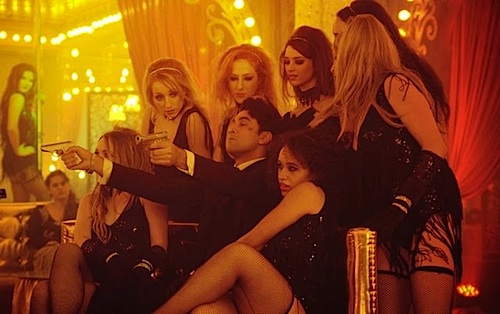By Joe Bendel. Probably no other Swiss dude ever creeped out as many people as Hansruedi “H.R.” Giger—and his fans loved him for it. His ominous visions of sexualized dystopias are uniquely distinctive and immediately identifiable as Giger. He was an artist with a rabid fanbase who was also steadily gaining stature in the proper museum world, like a Warhol with talent. One year after his death, almost to the date (5/12/2014), documentarian Belinda Sallin introduces fans into the cult figure’s private life in Dark Star: H.R. Giger’s World, which opened last Friday in New York.
Giger’s designs for Jodorowsky’s oh-so-close-to-being-realized Dune could have stood the film world on its ear, but that is a lament for another documentary. However, connections initially made through the celebrated non-film subsequently led to Giger’s Oscar winning design work for Ridley Scott’s Alien. Giger’s fate would not be denied. Perhaps Giger’s most recognizable album cover is Emerson, Lake & Palmer’s Brain Salad Surgery, but arguably just about every 1980s Heavy Metal cover owes him a debt of gratitude.

It is hard to make a dull film about someone who is regularly asked to sign body parts (as we see from time to time), but Dark Star quietly gets off to a slow start. There is a lot of milling around Giger’s Escher-esque house, as he graciously hosts friends and family. It is nice to know Giger’s final months were pleasant, but the film only starts getting interesting when it explores the psychological roots of his macabre, futuristic images. Much of the film’s psychoanalyzing is appropriately done by Czech psychiatrist and Giger crony Stanislav Grof (a good head-shrinker name if ever there was one).
It is fascinating to contrast Giger’s nightmarish images with his genial presence. Physically, the artist had clearly lost a step or two, but he was as sharp (and eccentric) as ever. Of course, his art is really the main attraction and it has lost none of its potency. Sallin’s basic strategy was to hang out and capture as many telling moments as she could. It is not a radical approach, but it will suit Giger’s fans (many of whom are large tattooed men you should not antagonize).
Dark Star is a reasonably compelling and wholly respectful portrait of an artist in his final days. It is nice to have it for posterity, but everyone would prefer Jodorowsky’s Dune if that were somehow an option. Recommended for Giger fans, Dark Star: H.R. Giger’s World opens today (5/15) in New York, at the Landmark Sunshine.
LFM GRADE: B-
Posted on May 18th, 2015 at 10:05pm.




